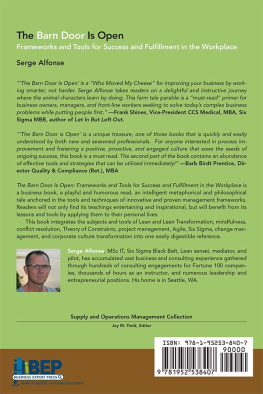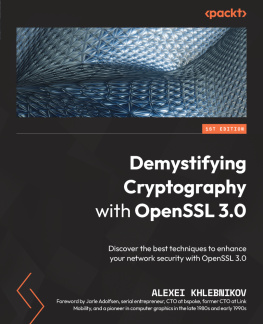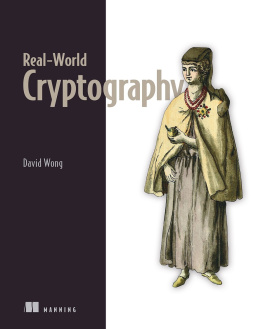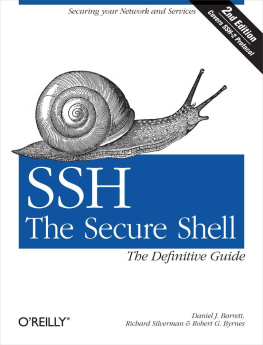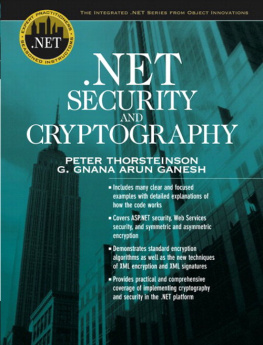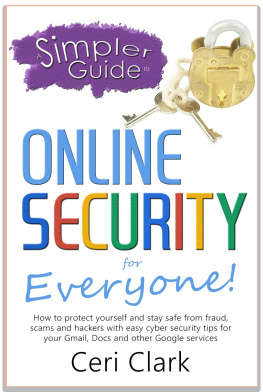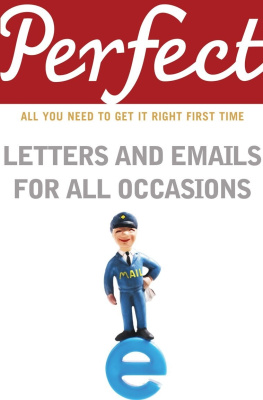Fiskerstrand - Sending Emails The Safe Way
Here you can read online Fiskerstrand - Sending Emails The Safe Way full text of the book (entire story) in english for free. Download pdf and epub, get meaning, cover and reviews about this ebook. year: 2011, genre: Home and family. Description of the work, (preface) as well as reviews are available. Best literature library LitArk.com created for fans of good reading and offers a wide selection of genres:
Romance novel
Science fiction
Adventure
Detective
Science
History
Home and family
Prose
Art
Politics
Computer
Non-fiction
Religion
Business
Children
Humor
Choose a favorite category and find really read worthwhile books. Enjoy immersion in the world of imagination, feel the emotions of the characters or learn something new for yourself, make an fascinating discovery.
- Book:Sending Emails The Safe Way
- Author:
- Genre:
- Year:2011
- Rating:5 / 5
- Favourites:Add to favourites
- Your mark:
- 100
- 1
- 2
- 3
- 4
- 5
Sending Emails The Safe Way: summary, description and annotation
We offer to read an annotation, description, summary or preface (depends on what the author of the book "Sending Emails The Safe Way" wrote himself). If you haven't found the necessary information about the book — write in the comments, we will try to find it.
There is an old proverb stating: There is no use closing the door, once the horse has left
the barn. Sadly many ignore any security considerations, often on a basis
of claiming it too difficult of a concept to grasp. The aim of this book is to guide you thruogh the necessary steps in order for your to better secure your communication through the use of dicitial signatures and encryption, using tools that are all free of charge.
Sending Emails The Safe Way — read online for free the complete book (whole text) full work
Below is the text of the book, divided by pages. System saving the place of the last page read, allows you to conveniently read the book "Sending Emails The Safe Way" online for free, without having to search again every time where you left off. Put a bookmark, and you can go to the page where you finished reading at any time.
Font size:
Interval:
Bookmark:
Talking to an acquaintance on the phone, it is generally easy to know whether you're talking to the one you expected. This is however not necessarily as easy when sending an email. As a result the credibility of email messages in general is lower and implicitly many would rather talk to someone one the phone over sending an email, despite email's advantages for efficient communication. And there are many advantages: Email is an asymmetrical form of communication which doesn't require the other party to be present at the exact time you yourself have the time for it. It gives both the sender and the recipient time to properly formulate the communique in an unambiguous way, as well as do the necessary research for the information contained to be as accurate as possible. Our focus here will however be on another aspect: Emails enables the possibility of secure communication. There is an old proverb stating: There is no use closing the door, once the horse has left the barn . Sadly many ignore any security considerations, often on a basis of claiming it too difficult of a concept to grasp. This excuse is often used until, and sometimes even after, the issue is overdue escalation. It is about time for this to change. Since you are already reading this book I hope you don't do so because you just had a security breach, or if you do; I urge you to inform others of your reasoning in order to help them be pro-active in protecting their privacy and their data and hope that the results in your own case did not lead to any permanent ramifications. Because security is usually considered a secondary, or even tertian need, it increases the difficulty of educating people. We do not generally sit down in front of our computer wanting to manage our security. Rather we want to send emails, browse web pages, download software, and we want security in place to protect us while we do these things. A paper written in 1998 named Usability of Security: A Case Study by Alma Whitte and J.D. Tygar, where they call this element the unmotivated user property discusses this. It follows up by defining the abstraction property which states Computer security management often involves security policies, which are systems of abstract rules for deciding whether to grant accesses to resources. The creation and management of such rules is an activity that programmers take for granted, but which may be alien and unintuitive to many members of the wider user population.
Combining the effect of the abstraction property and the unmotivated user property can give scary results. The general user will not understand the basis for the policies put forth in security applications without education, but at the same time, the general user is not to be expected to be interested in learning about security.
This book is logically divided into two. A great deal of the content is a generic introduction to digital signatures and encryption on a general basis. The rest will, however be quite practical. Hopefully both parts are useful to you.
Bruce Schneier is often quoted with an expression stating: Security is a process, not a product . Hopefully this book can help you gaining both interest and knowledge into the process of securing your email communication as well as your data, and help you increase the credibility of emails, by sending emails the safe way.
A digital signature is a part of the email that, when properly implemented, is mostly invisible to the user. It does however have some unique features that makes it very valuable to add credibility for those seeking it. As opposed to an analog signature of a standard letter, digital signatures for our purposes accomplishes two goals. The first use is to verify the sender ( authentication ). This is also done by an analogue signature, if you know the persons handwriting well enough and trust that the signature is not a copy. However, a digital signature also verifies that the content has not been tampered with ( data integrity ), because, opposed to analogue signatures, the digital signature is created based on the content it signs, using a digest algorithm as discussed later in this book. If anyone were to change the content of a digitally signed document, the signature would be invalidated.
Historically both of these functions were performed by the use of seals. In a time with limited resources and knowledge with regards to the art of deception it often served the purpose well. Today's attackers are however slightly more sophisticated. The thing is, an ordinary signature today means little or nothing at all. People change the handwriting over time, and how the signature gets depends on the context it is singed in; the available space to sign on, if it is rushed or not, what kind of pen is used et cetera. But probably the greatest problem is the recipient's ability to properly verify that the signature actually comes from the intended sender. Digital signatures are far superior to analogue signatures in each aspect, and this gives email an advantage over both ordinary letters and faxes, if used properly, which you hopefully will be guided to by reading this book.
If you run any kind of business you want to be able to know that the sender of the email is the one that first ordered your services. For instance a web hosting company receiving an email asking for the password of one of the domain hosting services to be reset, or the file permissions assigned to a different user. You will want proof that the sender is whom he claims to be, and if the user submitted a public key e.g. when paying for the package, this can easily be handled.
Another good practical example where the use of digital signatures vital is signing of software packages or other files that are to be distributed, exempli gratia over the Internet. Presuming that you have gotten the public key through a trusted source, or when downloading the last version of the program, you can then use the signature to verify that the file has not been altered. A real world example where this would have helped is with regards to the Internet Relay Chat (IRC) client BitchX, that came under attack using Domain Name Server (DNS) poisoning. Without going into too many technical details, which would bore most, in summary people downloaded a copy of it that contained spyware, because the download got directed to another server than the official one.
Two-hundred and fifty users of the Swedish bank Nordea got their bank accounts tapped after first having been infected with a modified version of the trojan horse haxdoor resulting in a loss for the bank of about $1.2 Million USD.
The term trojan horse was coined as a result of a historic event between the Greek and Trojans in the city of Troy. The Greek offered a wooden horse as a gift to the Trojans, allowing the greeks hidden in the horse access behind the walls of the city. The analogy of this is wildly used in computer terminology today, representing a virus or worm opens a backdoor to the system for malicious individuals to connect, and gain control of, the system.
Data/Content that can be read and understood without any special measures is called plaintext , or cleartext . When you go through the encryption process you get ciphertext as output, data that can appear garbled and has to be decrypted before it once again can be read as cleartext. Cryptography is the science of using mathematics to encrypt and decrypt data. It enables you to store sensitive information or transmit it across insecure channels (like the Internet) so that it cannot be read by anyone except the intended recipients. While cryptography is the science of securing data, cryptanalysis is the science of analysing and breaking secure communication. Classical cryptanalysis involves a combination of analytical reasoning, application of mathematical tools, pattern finding, patience, determination and luck. Cryptology covers both cryptography and cryptanalysis. Lets start off by a simple question: Do you write down sensitive data on the back of a postcard? If the answer is no and I hope it is, why not? Because you know, that anyone dealing with the mail under ways; postal workers, the delivery guy, or anyone peaking in your mailbox, can read it. The same goes for e-mail, except then it's done electronically in a matter of seconds. Why do you put mail in an envelope? Breaking a sealed envelope is a felony in most countries, and as such it adds a level of judicial protection to the content in addition to making it more difficult to read. The solution for putting emails in an envelope is even harder to break through, but not necessarily more difficult to apply; it is called encryption.
Font size:
Interval:
Bookmark:
Similar books «Sending Emails The Safe Way»
Look at similar books to Sending Emails The Safe Way. We have selected literature similar in name and meaning in the hope of providing readers with more options to find new, interesting, not yet read works.
Discussion, reviews of the book Sending Emails The Safe Way and just readers' own opinions. Leave your comments, write what you think about the work, its meaning or the main characters. Specify what exactly you liked and what you didn't like, and why you think so.




